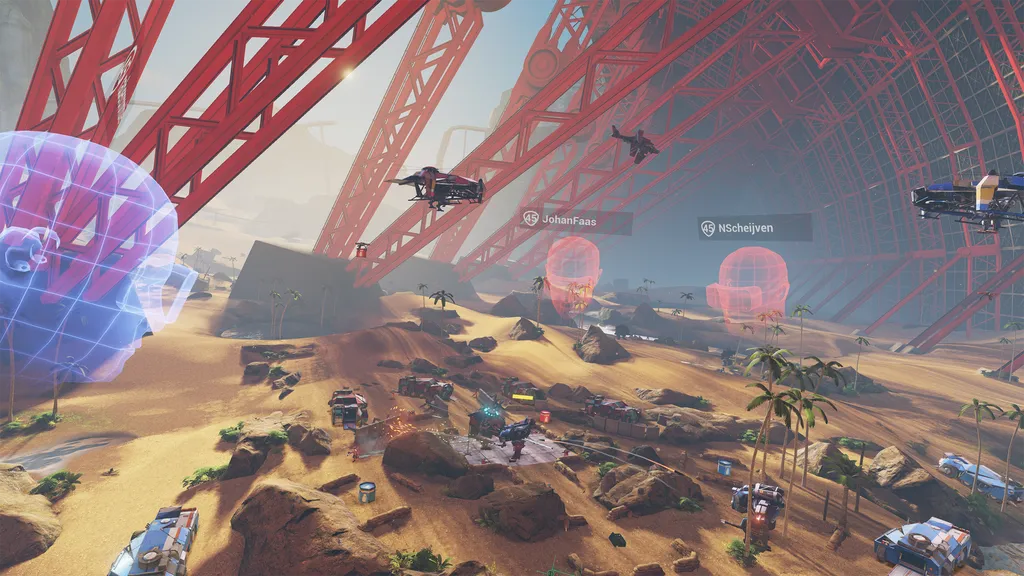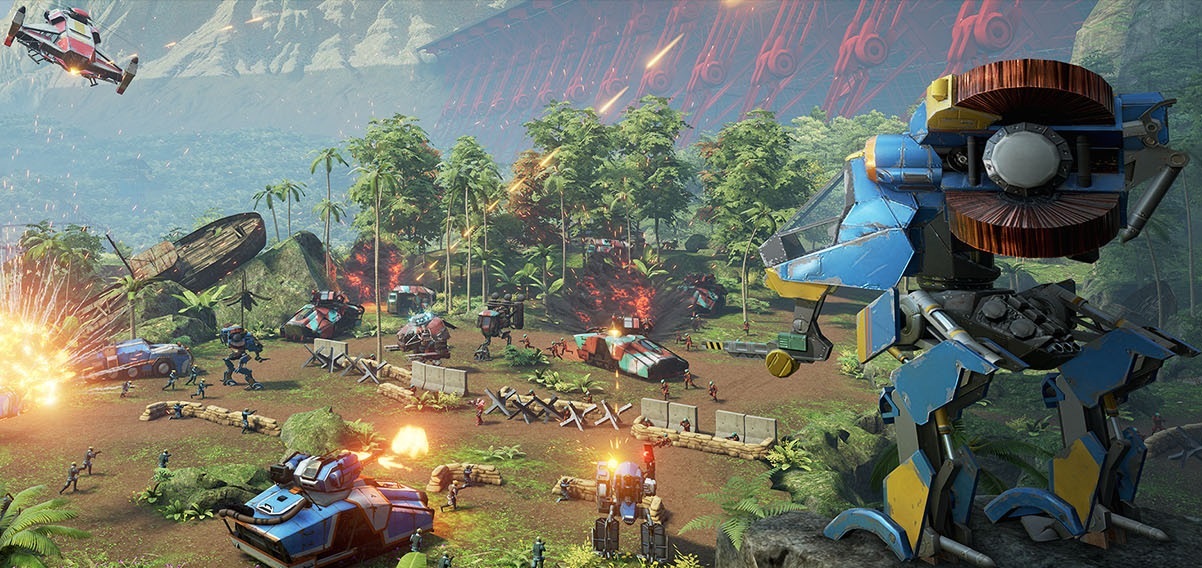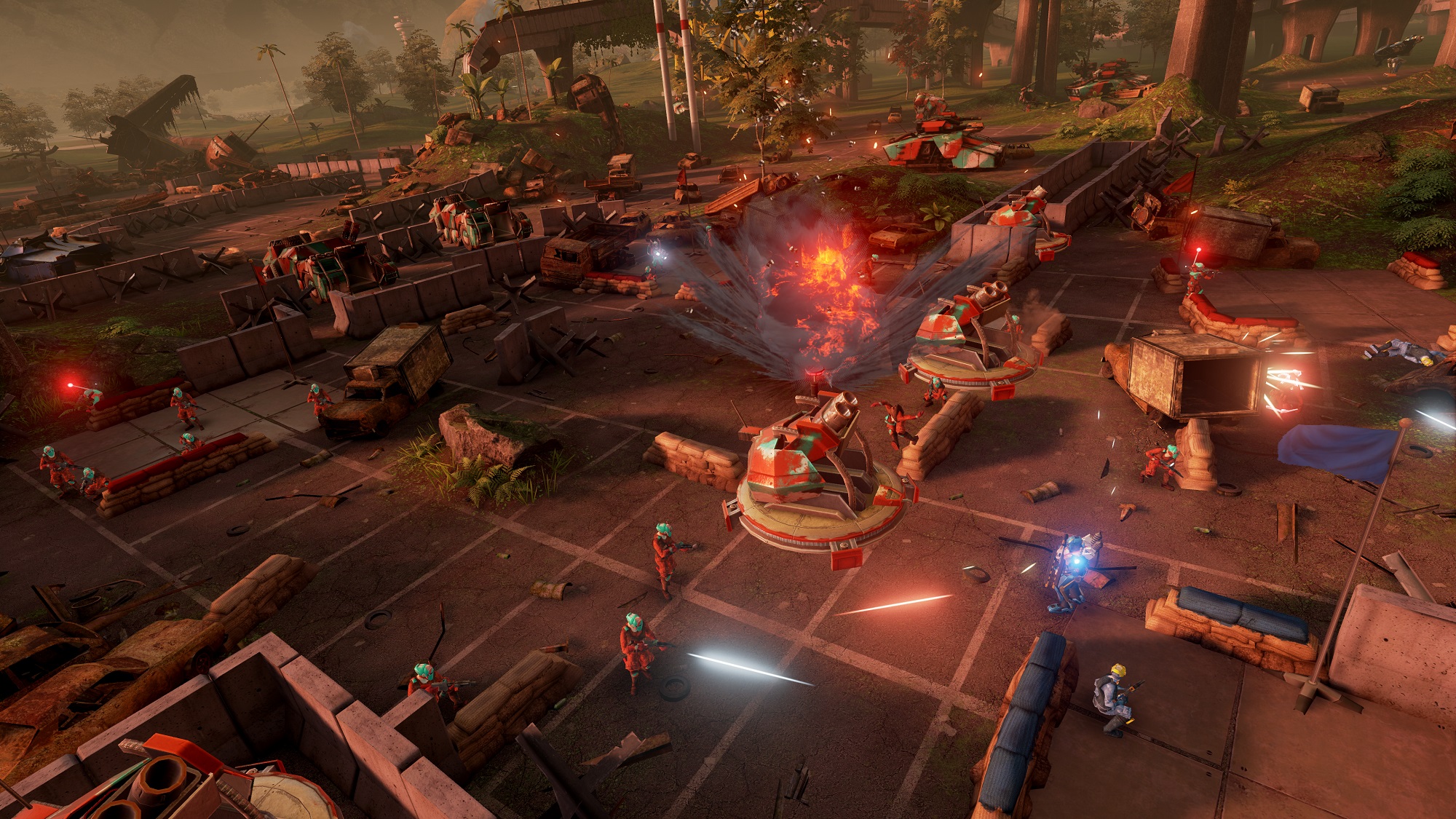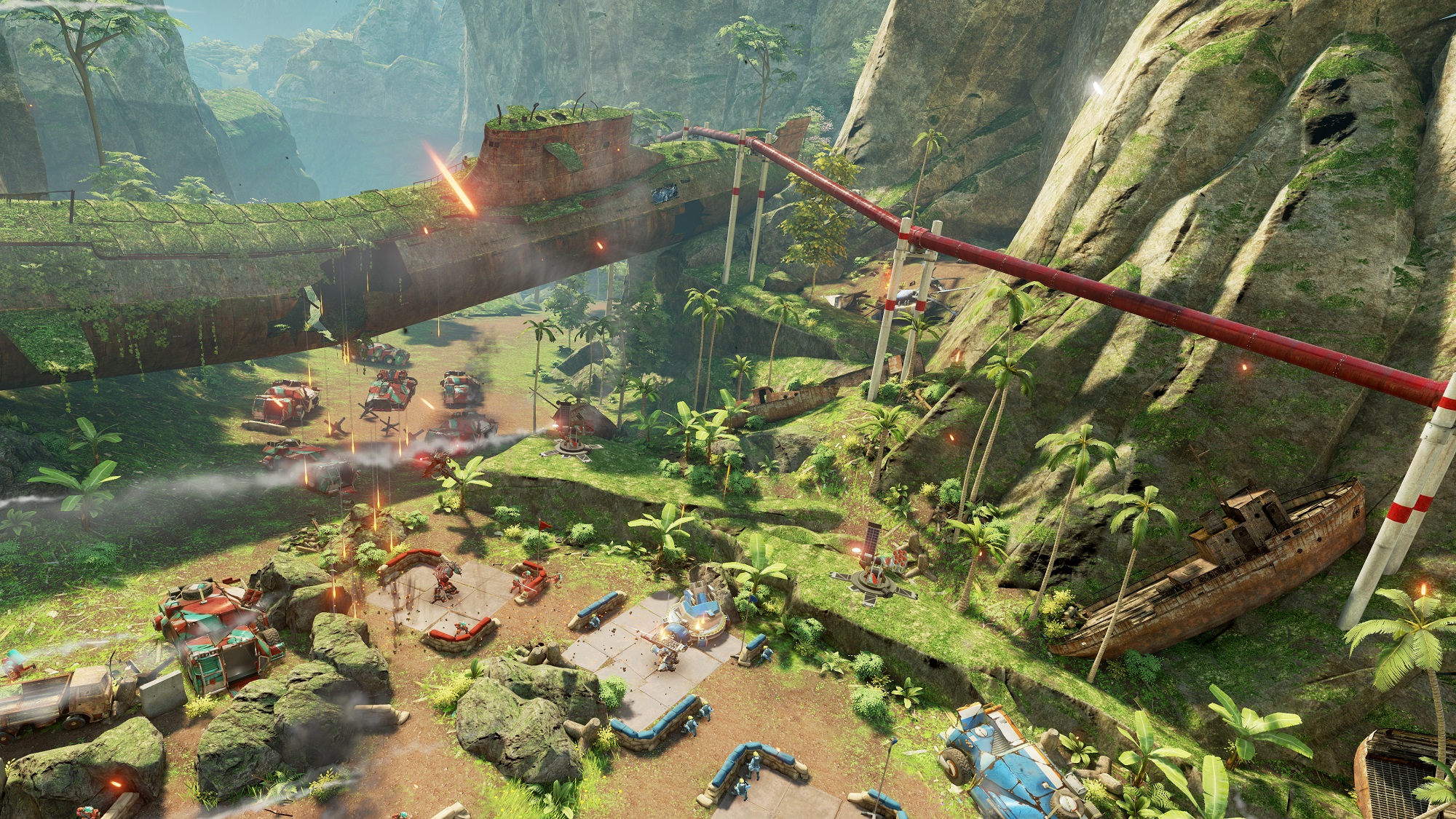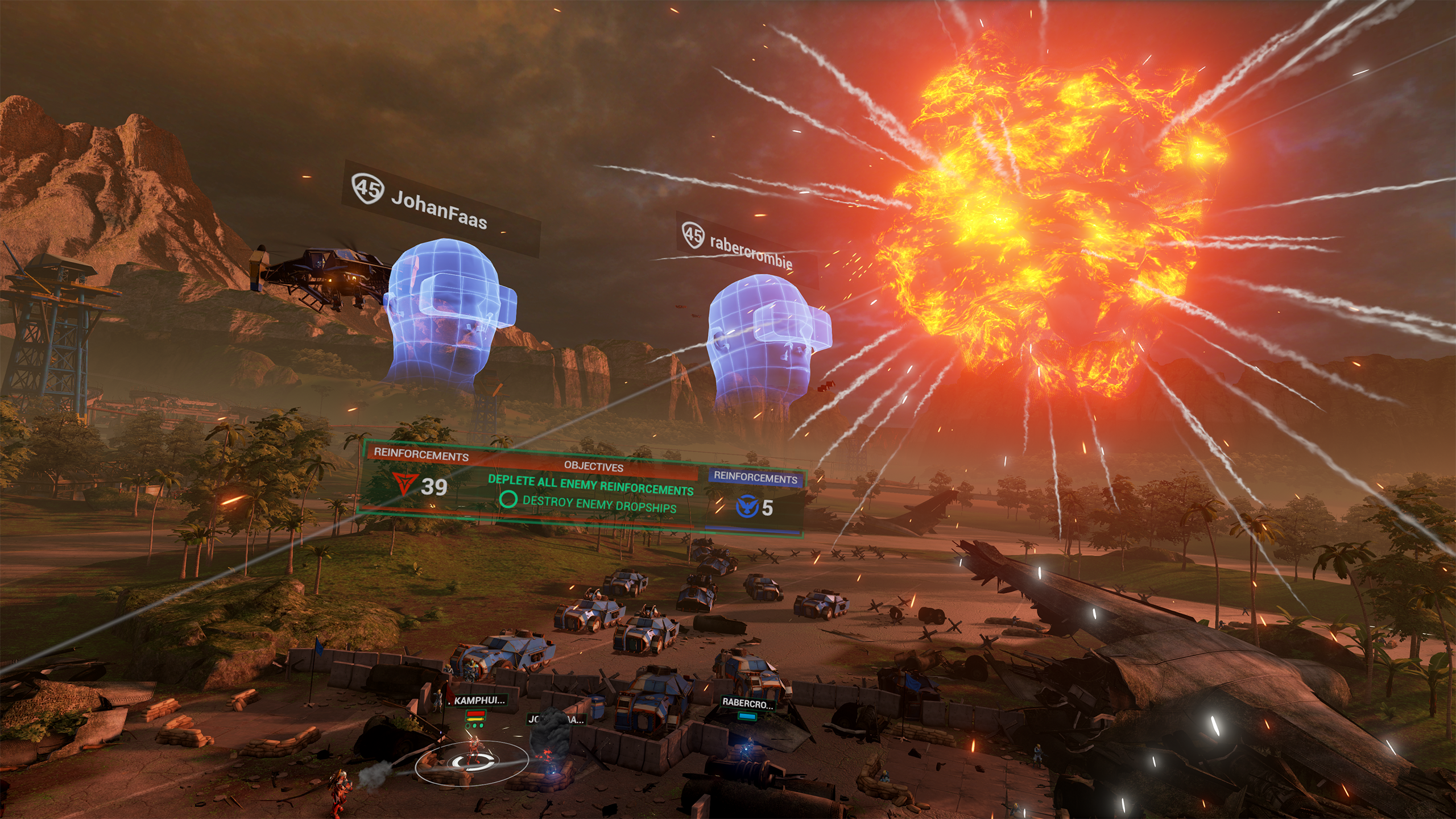When I was a young child my friends and I used to orchestrate elaborate games of Lego-crafted warfare. We hadn’t heard of Warhammer 40,000 or we likely would have been addicted, so what we did instead is create elaborate bases from Lego bricks at opposite ends of my room. We would then craft vehicles and transport ships to move our troops (Lego figures) across the battlefield (my carpet). We’d roll dice to see how far we could move units and launch projectiles to see which bricks were blown off (flicked with our fingers to simulate damage). It was a scattered, imprecise, and incredibly chaotic house rule-driven game of war, Legos, and destruction.
I’ve got fond memories of those made-up games of Lego War (that’s what we called it) and Landfall on the Oculus Rift, the first virtual reality (VR) game from newly formed game studio Force Field reminds me of it quite acutely. During my recent preview of the game, I likened it to Halo Wars meets a twin-stick shooter and after spending several more hours between the single player campaign and multiplayer game modes, I can safely admit that comparison rings truer now more than ever.
In Landfall you’ll take control a super-powered soldier at the helm of a group of specially trained operatives fighting for either the red or blue team. The campaign is split up into several missions that serve as an excellent way to not only learn the fundamentals of the game, but also how to play each of the complex class loadouts. The story is trivial at best, but does feature some solid voice acting if you’re paying attention. Like most wars, the battles in Landfall are fought over the ownership of land and valuable resources. Those motivations just don’t really bleed into the shooting and killing enough to pay attention to it after the opening cinematic.
During actual battles, your soldier has a special assortment of equipment depending on which loadout you chose. They’re all controlled the exact same way, but differ in terms of which weapons they actually carry. For example, regardless of which loadout you choose, the same buttons are used for shooting your primary weapon, throwing your specific type of grenade, and calling down your massive mech suit/robot hybrid strider. They look and feel like titans from the Titanfall series, but move at a much slower pace.
Since the entire game takes place from a top-down perspective, it’s unlike any other shooter you’ve played in VR so far. It at first feels a bit like a strategy game, such as AirMech Command, but that comparison only works in terms of the visual style and perspective. In Landfall you don’t build bases or issue commands, but instead control just your single hero unit.
Every mission is a collection of smaller objective-based games that take place at different locations throughout an overall environment theme. The types of games range from simple deathmatch style battles and objective captures, to more elaborate point capture-and-hold missions, or even escort assignments. That fluctuation and variety is what kept me coming back for more while playing and will likely keep people engaged long after release. No two matches ever felt the same as I was changing loadouts, switching sides, and swapping partners frequently.
While it doesn’t add much to the experience, the Oculus Touch controllers are technically supported. There is no motion functionality, as the buttons are simply remapped to the individual Touch controllers as if they were a standard gamepad. This didn’t feel appropriate to me and I found myself using an Xbox One controller in all instances after testing Touch once in this game.
But don’t let the game’s lack of first-person antics and motion controller support fool you: Landfall is better because of VR. Your HMD lets you get closer to the action and see it from new perspectives you couldn’t otherwise. You can see where your opponent’s avatar is looking and you can inspect other areas of the map while your unit is still being controlled out of sight with the gamepad. Rather than looking at a screen, you feel like you’re floating in the sky; you become an all-powerful God of War.
While the core of single player and multiplayer is the same, the real meat of the game exists online. As a result, playing with other people comes in three basic flavors: cooperative, 1v1, and 2v2. The entire campaign is playable from start to finish in co-op, which is a great way to learn the game together with a friend. But once you’re off the ropes and know the basics, the real fun is found online.
As you play either 1v1 or 2v2 matches, you’ll gain experience points (XP) based on performance and level up. With each level you increase, you also earn the ability to choose a new loadout to unlock. For the first dozen or so levels, this creates a steady stream of fresh content to explore, especially considering it takes several matches before you can really grasp the nuances of each unit and accompanying strider.
For example, playing with a loadout that has a default short-rang burst machine gun as opposed to a single-shot long-range sniper rifle is almost like two totally different games.
Some units are better at capturing points, while others are better at getting kills. Some units are better at taking down other striders, while some are better at defending a position. You can return to your base and change loadouts at any time, or swap when you respawn.
During my time with Landfall I was just aching to see more people in the game. Playing with colleagues, peers, and developers is great — but I want to see what the VR community does once they get their hands on striders of their own outside of the Beta weekend.
Landfall feels like the type of game that will live and die by the frequency and quality of its updates. 12 loadouts is an excellent start, but new gear, classes, and maps will be necessary on a consistent basis to keep people interested. Luckily, the complete single player campaign is more than sufficient to satisfy urges if servers get quiet.
With Landfall, Force Field has delivered one of the best examples of gamepad-focused VR we’ve seen in some time. The action is intense, the gameplay is crisp and precise, and the tactical strategy required to emerge victorious feels both creative and fresh. Updates will be needed to keep people coming back for more, but this is an excellent twin-stick shooter that delivers on all fronts.
Landfall is available starting today for Oculus Rift on the Oculus Home Store for $29.99. Read our Game Review Guidelines for more information on how we arrived at this score.

